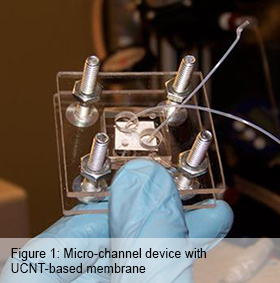Yang Hui Ying
This low-energy and cost-effective process uses carbon nanomaterials as the electrode in capacitive deionisation to remove salt from water. Besides benefiting developing countries, resource-limited areas and those who are unable to afford desalinated water, the technology may help lower the cost of water in Singapore.
New technology for water desalination and purification
Scientists and engineers from the Singapore University of Technology and Design (SUTD) have discovered a new alternative to purify water. The team led by Dr Yang Hui Ying discovered that plasma-modified ultralong carbon nanotubes (UCNTs) have an absorption capacity to desalinate water of about two orders of magnitude (approximately 200 times) larger than that of current state of-the-art activated carbon-based water treatment systems. Dr Yang and her team’s findings have been published in the August 2013 issue of Nature Communications.
To meet the need for clean water around the world, especially in areas where infrastructure is not well developed, researchers have been searching for alternatives to large-scale desalination plants, which are difficult to implement. This is because these water treatment technologies usually consume large amount of energy, involve high operating cost and require extensive infrastructure. Therefore, there is increasing interest in smaller portable water purification devices that house activated carbons – a material that adsorbs contaminants. However, such devices are often limited by their capacity to remove salt.
 Dr Yang and her team exposed UCNT-based membranes to plasma treatment, which successfully enhanced the desalination efficiency of the UCNT-based membranes. The modified membranes utilized their ultrahigh adsorption capacity to remove salt from solutions, and because salt was adsorbed rather than rejected, the required operation pressure was also significantly less than that required by traditional reverse osmosis processes. The team incorporated the plasma-modified UCNT-based membranes into a micro-channel device to test the performance of the membranes. They found that the modified UCNT-based membranes not only efficiently desalinate water, but also effectively and simultaneously remove organic contaminants and heavy metal nanoparticles that are linked to waterborne diseases.
Dr Yang and her team exposed UCNT-based membranes to plasma treatment, which successfully enhanced the desalination efficiency of the UCNT-based membranes. The modified membranes utilized their ultrahigh adsorption capacity to remove salt from solutions, and because salt was adsorbed rather than rejected, the required operation pressure was also significantly less than that required by traditional reverse osmosis processes. The team incorporated the plasma-modified UCNT-based membranes into a micro-channel device to test the performance of the membranes. They found that the modified UCNT-based membranes not only efficiently desalinate water, but also effectively and simultaneously remove organic contaminants and heavy metal nanoparticles that are linked to waterborne diseases.
 Moreover, the adsorption capacity of the resultant UCNT-based membranes was easily recovered by rinsing with tap water. As the modified membranes were mechanically robust and requires less energy, Dr Yang’s team anticipates rechargeable devices to be made using the newly-discovered UCNT-based membranes. Such portable devices could be carried on person to provide clean water and could be deployed in remote areas where continuous power supply is unavailable.
Moreover, the adsorption capacity of the resultant UCNT-based membranes was easily recovered by rinsing with tap water. As the modified membranes were mechanically robust and requires less energy, Dr Yang’s team anticipates rechargeable devices to be made using the newly-discovered UCNT-based membranes. Such portable devices could be carried on person to provide clean water and could be deployed in remote areas where continuous power supply is unavailable.
Dr Yang has filed a patent for this invention through SUTD’s Office of Technology and Enterprise Management. This work is supported by the SUTD International Design Center and the international research team includes Dr Zhao Jun Han and Prof Kostya Ostrikov from CISRO Materials Science and Engineering, Australia; Dr Siu Fung Yu from Hong Kong Polytechnic University, Hong Kong; Prof Pey Kin Leong from SUTD, Singapore; and Dr Rohit Karnik from Massachusetts Institute of Technology, United States.
Read more about it on Nature Communications.